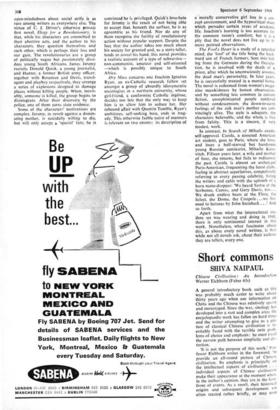Short commons
SHIVA NAIPAUL
Chinese Civilisation: An Introduction Werner Eichhom (Faber 65s) A general introductory book such as this was probably much easier to write about thirty years ago when our information on China and the Chinese was relatively sparse and stereotyped. Since the war, sinology has developed into a vast and complex area; the encyclopaedic work has fallen on hard times and the writer attempting to give us a pic- ture of classical Chinese civilisation is in- evitably faced with the terrible twin prob- lems of choice and emphasis: he must tread the narrow path between simplicity and dis- tortion.
'It is not the purpose of this work,' Pro- fessor Eichhorn writes in the foreword, 'to provide an all-round picture of Chinese civilisation. Its emphasis is principally on the intellectual aspects of civilisation . . • individual aspects of Chinese civilisation make their appearance at the moment when. in the author's opinion, they are in the fore- front of events. As a result, their historical origins and subsequent development are often treated rather briefly, or may even
be merely implied' Here. briefly, are the reasons for the book's failure.
It is a failure, not only of method, but of choice and emphasis as well. The idea of coherent development implied by the con- ientional progress through the dynasties is fine so long as we confine ourselves to a definite underlying theme. Without one, the unity of the book suffers and the chron- ology becomes illusory. The Intellectual aspects of civilisation' is too broad and vague a category and Professor Eichhom's definition of it seems, to say the least, capricious. Why is there no mention (apart from the invention of printing and paper) of Chinese science? It would have been illum- inating to ask why a people so inventive— one has only to glance at Joseph Needham's vast work, Science and Civilisation in China to realise the scope of their achievement— should have failed to exploit their dis- coveries.
But, science apart, we are given a little helping of everything (omission seems to leave the author with a guilty conscience despite his disclaimer) and not much of any- thing. Let us take one example. Although the examination system is described, the importance of the Confucian bureaucracy that ruled the country, and was one of the distinctive features of Chinese civilisation, is never fully brought out. The philosopher Mo-Tzu is given equal prominence with Confucius.
These are some of the larger criticisms. Unfortunately, the minor ones are equally irritating. Why are there no illustra- tions? What possible use can there be in a survey of Chinese painting without accom- panying illustrations? Moreover, much of the section on painting is given over to a dis- cussion of the T'ang (618-906) artists, pre- cious little of whose work survives. This, in the book's self-confessedly straitened cir- cumstances, is hardly justifiable. It becomes no more than a catalogue of names. On the other hand, the author has virtually nothing to say about the Shang (1766-1123 ac) bronzes, one of the glories of early Chinese art and workmanship, specimens of which have come down to us.
Professor Eichhorn writes well about the development of religion and the cult of ancestor worship; his account of urban life and festivals during the Sung (960-1279) is entertaining; and his account of the abortive attempt at reform by Wang An-Shih (1021- 1086) is lucid and informative, reminding us that behind all the sumptuousness of the Imperial Court lay the mass of the common people, the chief victims of famines, wars and exorbitant taxes. But elsewhere one is lost in a welter of competing themes and
yawning gaps of brevity and implication, not at all enlightening. Brevity might be a very considerable virtue but, in a book which sets out to describe the essential features of Chinese civilisation within the compass of three hundred pages, it easily slides into a very considerable vice.



































 Previous page
Previous page